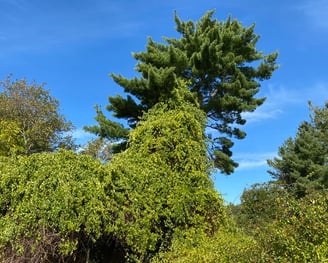Invasive Plant Primer
"Weeds are flowers too, once you get to know them.
"Invasive plants are not flowers. They are a menace. Some are downright demonic"
- B. Barkalow
- A. A. Milne
What is an Invasive Plant?


Invasive plants are a special kind of weed. They are not native to Maine or the new England region, and they cause harm to the natural environment, to human health, or to economic resources such as agriculture, forestry and tourism.
There are hundreds of different invasive plants in Maine. At Invasive Pest Control, our focus is on those that are known to cause harm to woodlands, field edges and wetlands - see below for more specifics.
For aquatic invasive plants, please contact Maine DEP or the Lake Stewards of Maine - Volunteer Lake Monitoring Program.
For species that are of concern in agricultural settings, please contact your local Cooperative Extension Office.
Bittersweet and multiflora rose strangling and smothering a mature white pine in Damariscotta.
How Did They Get Here?


Most invasive plants were brought into Maine or New England intentionally! Bittersweet makes a lovely Thanksgiving wreath and barberry also produces lovely fall berries, but these plants come at a high price to our native species. Only in recent years have the invasives become recognized as a growing threat, with state agencies now banning an ever-increasing number of plants for sale (see the current list here).
Once established, invasive plants work to do the same thing as every other organic lifeform: reproduce! For some plants, seeds are dispersed by birds or carried on the wind, while others rely on their rhizome root structure to expand their territory. In some cases, such as knotweed and bittersweet, the smallest piece of plant can be carried by wildlife or water to a new location and start a brand new infestation.
Bittersweet was probably planted in this garden area as an ornamental. A few years later, it is crowding out other ground cover and smothering trees.
When Should I Do Something?


Early detection, followed quickly with a strong response, is really the best defense. Unfortunately, that isn't always the case, and by the time it is noticed, the invasive plant has a firm foothold. The below chart illustrates the increasing cost as that foothold grows.
The chart also highlights the four types of control options that are generally available as an invasive becomes more widespread in an area. Over time, complete eradication from an infested area becomes more difficult and expensive.
The invasion curve. Adapted from Invasive Plants and Animals Policy Framework, State of Victoria, Department of Primary Industries, 2010. See: https://edis.ifas.ufl.edu/publication/UW392 (University of Fla.)
What Can I Do?


Prevent spreading seeds or pieces of plant. After spending time outdoors, check for and remove any stray bits of plant matter that may have attached to your shoes, pant cuffs or sleeves.
Learn to identify the most common problem plants in your area. Resources to help with this can be found in our Rogues Gallery.
Check your property with an invasive plant survey by a professional. Typically, this is not an expensive proposition, and Maine's Natural Areas Program even maintains a list of companies to help with this.
Act quickly and decisively when caught early to eradicate all traces of the problem plant. If you opt to use herbicide on your own property, please be cautious and follow all directions on the product label. Even the safest pesticides are dangerous!
Take a long view and be patient. Most invasive plants are tenacious, and will continue re-sprouting and coming back for one or more years. Be more tenacious and they will be controlled and eliminated.
Manual cutting/pulling saved this white pine from bittersweet and multiflora rose. The dead vines in the tree's branches become brittle over time and fall away in a year or so.
